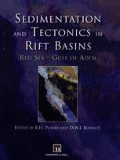Abstract
The 23 000-year-old sediments of the Atlantis II Deep lie on a basaltic substratum and are overlain by a hot NaCl-rich brine pool. In order to assess a geochemical model based on the sedimentological and chemical processes leading to the formation of the Atlantis II hydrothermal deposit, we have examined the chemical composition and the XRD data from 120 samples from two cores that sampled the entire sediment sequences of the Atlantis II Deep. A normative quantification of the temporal and spatial distribution of major mineral species (sulphides, sulphates, carbonates and oxides) enabled us to propose new lithological sequences that differ from those proposed by Bäcker and Richter (1973). These sequences are defined by genetic units labelled 1, 2, 3a–f, 4 and U and L for the western and south-western basins, respectively. The units are characterized by specific mineral associations deriving from hydrothermal inputs, biogenic and detrital sedimentation and from intensive secondary transformations. The supplied biogenic and hydrothermal particles acted as precursors for stable phases that accumulated within the sediment and participated with several chemical processes involving acid-base and redox reactions. Thus, we defined a Fe-Mn redox cycle relating to the removal of Mn++ and the formation of ferrihydrite that incorporated silica in its structure. Ferrihydrite has been partly transformed into goethite or haematite as a function of the temperature and the metal content of the solution in equilibrium. Lepidocrosite and akaganeite acted eventually as precursors for these oxides. The reactions of carbonate dissolution and oxidation of dissolved H2S by Fe-oxides acted as the main pH buffer of the brine during the discharge of acid hydrothermal fluid, and permitted the precipitation at the equilibrium of carbonate solid solutions and occasionally anhydrite, respectively. The geochemical mechanisms leading to the formation of the Atlantis II ore deposits proceeded in different environments during the history of the deep. The precipitation of sulphides and sulphates by quenching effect are located in the vicinity of discharge sites of the hydrothermal fluid. If Zn, Fe and H2S are in excess in reduced solution, ZnS and FeS2 could, however, precipitate at the equilibrium far from the hydrothermal fluid springs. The precipitation of Fe and Mn-oxides operated at the sea water-brine interface. The authigenic carbonates were formed in the upper part of the reduced lower brine where the concentrations of dissolved Fe and Mn were high and where CO− 3 was realized by the dissolution of biogenic carbonates. The Fe-Mn redox cycle worked in the lower brine. The Fe and Mn-oxides were transformed into more stable phases after their settling into the sediment. The formation of carbonate solid solutions and pyrite of unit 1 resulted from reactions of early diagenesis relative to the bacterial activity. Faunal associations showed that unit 4 is contemporaneous with unit U. Mineral associations indicate that unit 3f (Mn-oxides) is contemporaneous to unit L (anhydrite and Fe-oxides). Lateral bathymétric variations and changes of the hydrodynamic regime within the brine pool explained the differences in mineralogy and thickness between the correlated units. The proposed geochemical model includes chemical processes that acted at temperatures lower than 250°C and pH range from 4 to alkaline pH of sea water during the entire hydrothermal history of the Atlantis II Deep.
Access this chapter
Tax calculation will be finalised at checkout
Purchases are for personal use only
Preview
Unable to display preview. Download preview PDF.
Editor information
Editors and Affiliations
Rights and permissions
Copyright information
© 1998 Springer Science+Business Media Dordrecht
About this chapter
Cite this chapter
Blanc, G., Anschutz, P., Pierret, MC. (1998). Metalliferous sedimentation in the Atlantis II Deep: a geochemical insight. In: Purser, B.H., Bosence, D.W.J. (eds) Sedimentation and Tectonics in Rift Basins Red Sea:- Gulf of Aden. Springer, Dordrecht. https://doi.org/10.1007/978-94-011-4930-3_27
Download citation
DOI: https://doi.org/10.1007/978-94-011-4930-3_27
Publisher Name: Springer, Dordrecht
Print ISBN: 978-94-010-6068-4
Online ISBN: 978-94-011-4930-3
eBook Packages: Springer Book Archive

